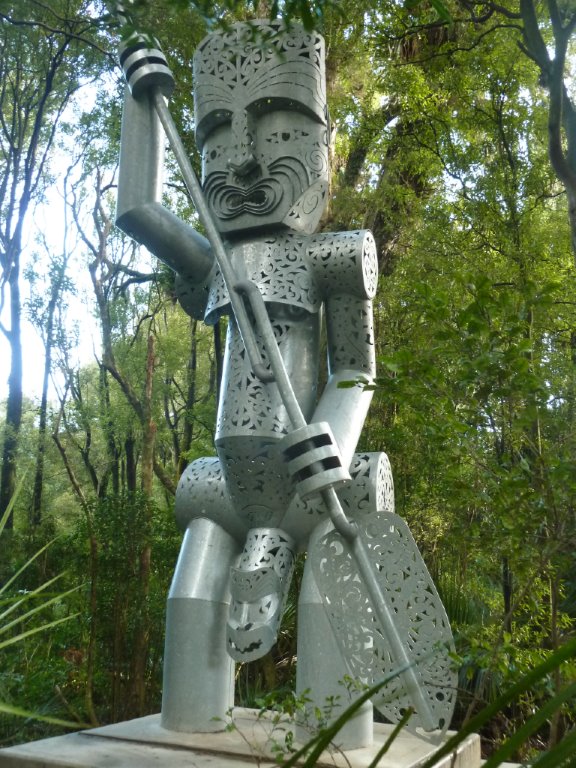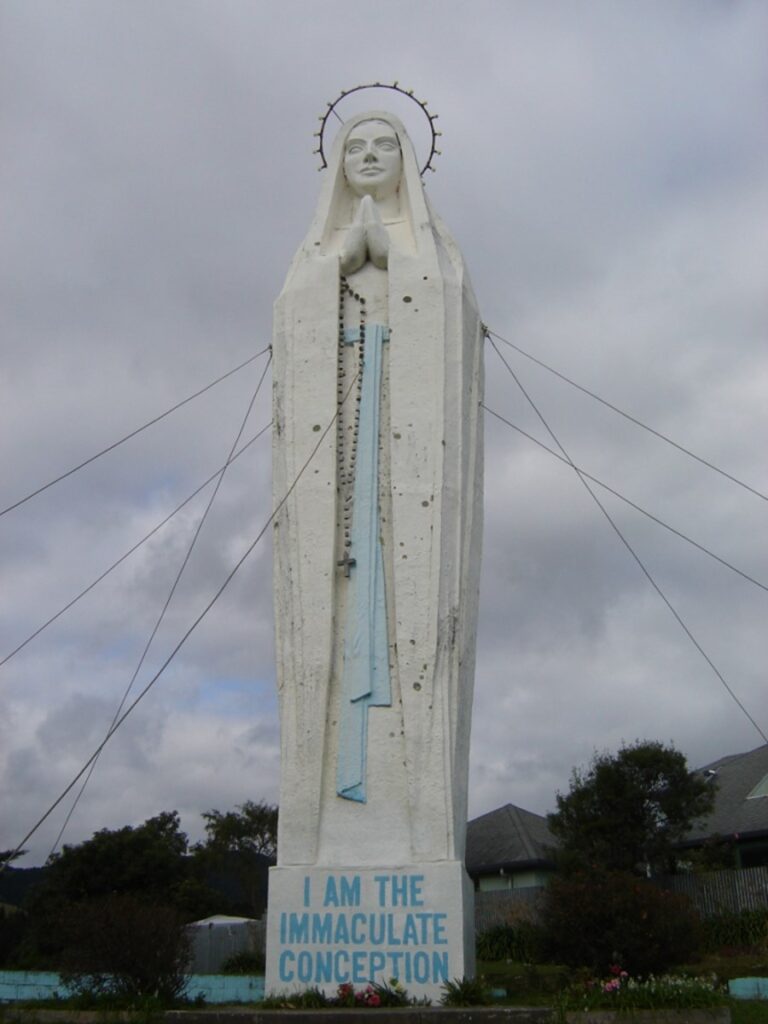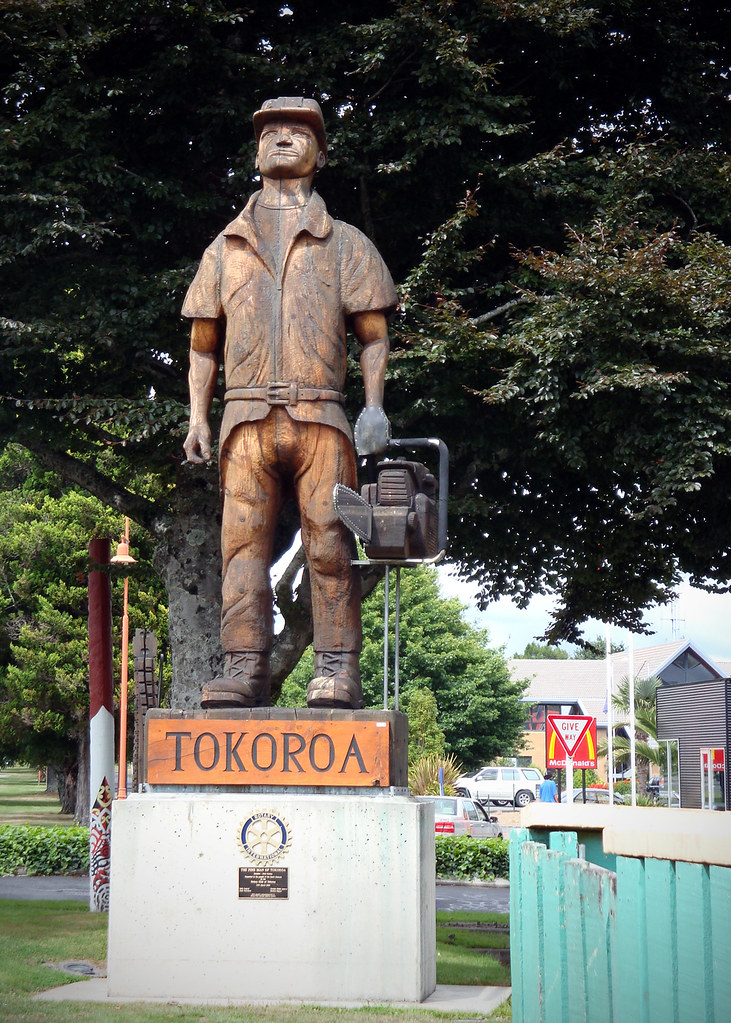METALLIC MAORI
Maori navigator, Whatonga was born in Hawaiki about 1130. While he was competing in a regatta a sudden storm blew his canoe out to sea. After his return to Hawaiki he fitted out a large canoe and sailed to New Zealand, making landfall at North Cape then sailed down the coast and settled for a while on Mahia Peninsula. From there he sent his two sons to find a more suitable place for permanent settlement. Their first choice was at Somes Island but they later moved to Miramar Island then Kapiti.
Hidden away in the bush in the Manawatu Gorge stands a huge metallic statue representing this Maori explorer. It faces out towards Castlepoint which is where Whatonga is believed to have first stepped ashore on this part of the island. Part of the popular short walk known as the Tawa Loop, the chunky 6.2metre (20ft) artwork was created by local artist, Paul Horton who used traditional elements with modern construction techniques to create this very unusual metal statue. Constructed in steel with detailed patterns called mangōpare shark head, it was designed to symbolize the sailing history of Whatonga and is one of the main highlights for those walking the Tawa Loop.
OUR LADY OF LOURDES
One of the most dramatic landmarks on the Kāpiti Coast is a 14-metre-high (46ft) statue of the Virgin Mary on the hill above St Patrick’s Church. It is the only large religious statue in New Zealand and was commissioned by the parish priest, Father J.S. Dunn in 1958 to mark the 100th anniversary of the apparition of the Virgin Mary at Lourdes in France. It was to replace one previously built by some Marist brothers which had blown over in a storm. A Dutch religious artist, Martin Roestenberg, who immigrated to New Zealand in 1951, built the present statue, one of the largest of its kind in the world. He moulded the 2m (6ft) head in a garage at his home at Taihape. At the site, a crane lifted the head onto scaffolding. The statue was created from the head downward as layers of plaster were applied to scrim and moulded into shape, a somewhat difficult operation. A small door in the base gives access to a trapdoor leading up to the head. For six months through a winter of cold gales the artist persevered until, in August 1958, the massive statue was completed with its crown of 17 lights.
On the 19th October 1958, over 6,000 people marched through Paraparaumu to attend the statue’s dedication. It is rather simplistic in its form with strong angular lines and it has to be said, it is rather roughly finished. A series of guy lines are a bit of a distraction but do give added support during the frequent gales that attack this part of New Zealand. When floodlit, its sparkling halo is visible for kilometres. Recently, to protect it from vandalism and weathering, the statue was protected by several layers of fibreglass. ‘Stations of the Cross’, scenes of Christ’s passion in mosaics, were placed along the steep path to the statue.
PINE MAN
Tokoroa is a Waikato timber town so it is fitting that one of the largest wooden statues in the world should feature a timber worker. The pine wood used in this enormous carving came from the summit of an ancient pa (Maori defensive settlement) 30km (18miles) south of the town. In 2000, the cut trees were airlifted off the peak by helicopter and transported to Tokoroa by truck. There, they were milled to a uniform size then glued together to create the huge block of wood that would be transformed by artists Peter Dooley and Joe Wilkinson into the statue we see today. Officially called ‘The Timber Worker’ but better known as ‘The Pine Man’ the statue has stood beside the main road through the town since 2004 resolutely gazing upwards with a chain saw clutched in the hand on a muscular arm. In recent years, the wood has turned green and started to deteriorate but $29,000 in restoration work has ensured ‘The Pine Man’ will stand tall for many years to come.
Ceidrik Heward
Ceidrik Heward is an Amazon TOP SELLING AUTHOR and has lived and worked in 7 countries working as a TV cameraman, director and film tutor. For the past 17 years he has focused on writing and has been published in magazines and newspapers in Europe, USA, Asia and the Middle East.
His interests include photography, psychology and metaphysics. He loves to read and always has at least 3 books on the go. He has written 22 manuals/books and has just completed his 4th short novel. Ceidrik believes sharing information and stories is the best way to stimulate the imagination and enrich our lives.






















 Visit Today : 381
Visit Today : 381 Total Visit : 1133558
Total Visit : 1133558
Speak Your Mind